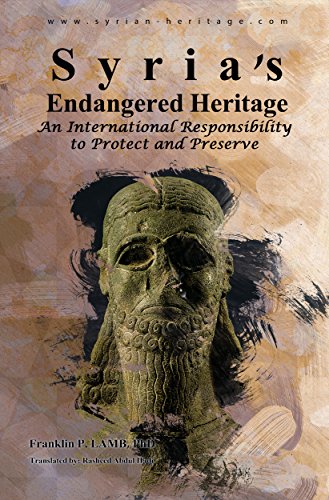Da'ish and like-minded jihadists deny their destruction of archeological sites in this region are acts of vandalism or terrorism. Rather, they argue that what they are doing is honorable religiously. It is obligatory "idol destruction." In a recent article in its online magazine Dabiq it is claimed that archeological sites like Palmyra must not be excavated and restored, but rather viewed with "disgust and hatred" and destroyed because they are pre-Islamic. ISIS propaganda claims the Islamist militants should be supported, even praised, for destroying idols or false gods and that their 'work' with bulldozers and jackhammers are following in the footsteps of the Prophet Mohammed, who smashed pagan statues in Mecca.
Among the greatest architectural monuments at the Palmyra site endangered at this hour is a wide, colonnaded street over half a mile long and the Temple of Baal, as well as a theater and the Agora. In addition, a Roman aqueduct and huge necropolises are on the outskirts.
According to UNESCO, "From the first to the second century, the art and architecture of Palmyra, standing at the crossroads of several civilizations, married Greco-Roman techniques with local traditions and Persian influences." The site "represents an irreplaceable treasure for the Syrian people and for the world," UNESCO Director-General Irina Bokova said on 5/15/2015. "I appeal to all parties to protect Palmyra and make every effort to prevent its destruction." The site has already suffered four years of conflict; it suffered from looting and represents an irreplaceable treasure for the Syrian people and for the world,"
A major watering hole and resting place for merchants' caravans on the old Silk Road, the trade route linked China and the Mediterranean. Palmyra grew rich levying tolls on traders passing through with spices and silks and slaves that it became known as the Bride of the Desert. But right now, today, yet another world wonder in Syria is on the brink of destruction.
Why Palmyra, matters?
A little context.
Palmyra is perhaps the last place anyone would expect to find a forest of stone columns and arches, according to Kevin Butcher, Professor in the Department of Classics and Ancient History at the University of Warwick and a specialist in the Roman Near East, "Travellers in the 17th and 18th centuries were repeatedly astonished by what they saw: a vast field of ruins in the middle of the Syrian desert, roughly half-way between the Mediterranean coast and the valley of the River Euphrates."
As noted above, the main reason for the site's prosperity is that ancient Palmyra sits at the edge of an oasis of date palms and gardens. It was a vital watering place on a trade route from the east and its very name "Palmyra" refers to the date palms that still cover much of the area. Its ts Semitic name, Tadmor, is a derivation from tamar, meaning "date palm."
According to Professor Butcher, from modest beginnings in the 1st Century BC, Palmyra gradually rose to prominence under the aegis of Rome until, during the 3rd Century AD, the city's rulers challenged Roman power and created an empire of their own that stretched from Turkey to Egypt. Palmyra was a thriving trade hub to rival any city in the Roman Empire its remains, including the ancient theatre, drew thousands of tourists annually before March 2011.
Locals speak proudly about Palmyra's Queen Zenobia, and this observer has met more than one young lady whose parents gave them her name. Zenobia fought against the Roman Emperor and also defeated the invading Persians. In the middle of the third century, when the Sasanians invaded the Roman Empire and captured the Emperor Valerian, it was the Palmyrenes who defeated them and drove them back across the Euphrates. In the context of today's regional geo-politics Zenobia takes on added symbolism.
Palmyra was a great Middle Eastern achievement, and was unlike any other city of the Roman Empire. It was simply unique, culturally and artistically. In other cities the landed elites normally controlled affairs, whereas in Palmyra a merchant class dominated the political life, and the Palmyrenes specialized in protecting merchant caravans crossing the desert. This observer has been honored to examine the well-preserved remains of edifices such as the great sanctuary of the Palmyrene Gods, the Temple of Bael), a grand colonnaded street and a theatre which as of today, still stands.
Palmyra has its own unique identity. The Palmyrenes were proud to adorn their buildings with monumental writing in their own Semitic script and language rather than relying exclusively on Greek or Latin which was used elsewhere in the empire. As Professor Butcher instructs us, Palmyra developed its own artistic style, and its own take on Classical architecture. Decorative patterns on its buildings and its inhabitants' styles of dress speak of widespread connections with east and west. Chinese silks have been found adorning mummies in Palmyrene tombs. Theirs was a cosmopolitan culture with an international outlook. Only small parts of the site have so far been excavated. Most of the archaeology lies just beneath the surface rather than deeply buried, and it is particularly vulnerable to looting. While gazing at the Temple of Bael some while back, this observers military escort pointed to a shovel and told me if I were to dig "anywhere around here" as he swept the horizon with his outstretched arm, I would find priceless treasures. Archeologists have only scratched the surface of the great expanse of Palmyra.
The next few days will be a test for humanity, a chance to take action before the crime against humanity is allowed to happen. The global community must take the decision without further delay to protect and preserve Syria's and all of ours shared global heritage.
Some of what can and must be done immediately:
(Note: You can view every article as one long page if you sign up as an Advocate Member, or higher).





